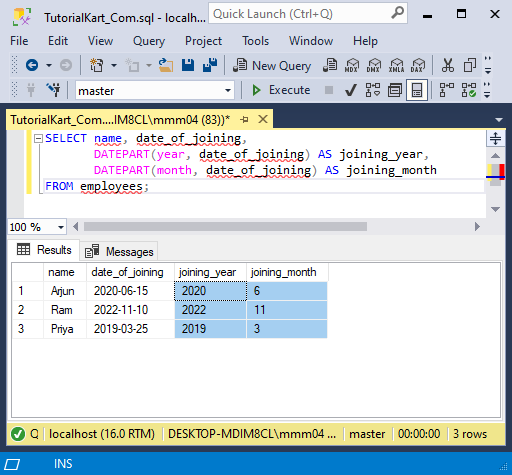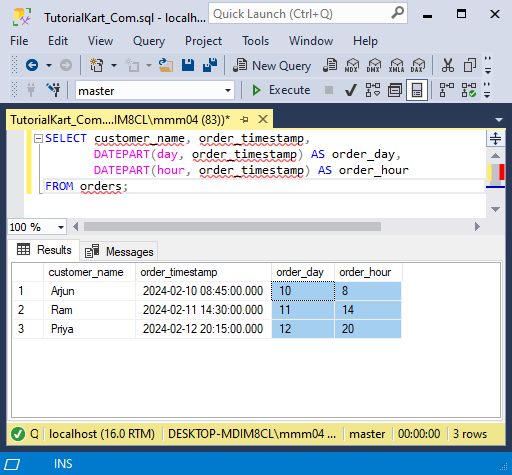SQL DATEPART()
The SQL DATEPART function is used to extract a specific part of a date, such as the year, month, day, hour, minute, or second. It is particularly useful when filtering or organizing data based on date-related values.
In this tutorial, we will explore the DATEPART function, its syntax, and practical usage through examples.
Syntax of SQL DATEPART
The basic syntax of the DATEPART function is:
SELECT DATEPART(datepart, date_value) AS result;Where:
datepart: Specifies the part of the date to extract (e.g.,year,month,day,hour, etc.).date_value: The date from which the part will be extracted.
Supported Date Parts in SQL DATEPART
| Date Part | Description | Example |
|---|---|---|
year / yy / yyyy | Extracts the year | DATEPART(year, '2024-02-12') → 2024 |
month / mm / m | Extracts the month | DATEPART(month, '2024-02-12') → 2 |
day / dd / d | Extracts the day | DATEPART(day, '2024-02-12') → 12 |
hour / hh | Extracts the hour | DATEPART(hour, '2024-02-12 14:30:00') → 14 |
minute / mi / n | Extracts the minute | DATEPART(minute, '2024-02-12 14:30:00') → 30 |
second / ss / s | Extracts the second | DATEPART(second, '2024-02-12 14:30:45') → 45 |
Step-by-Step Examples Using SQL DATEPART
1 Extracting Year and Month from a Date
Let’s create an employees table to demonstrate how to use the DATEPART function:
CREATE TABLE employees (
id INT PRIMARY KEY IDENTITY(1,1),
name VARCHAR(50),
date_of_joining DATE
);Insert sample data:
INSERT INTO employees (name, date_of_joining)
VALUES
('Arjun', '2020-06-15'),
('Ram', '2022-11-10'),
('Priya', '2019-03-25');Now, let’s extract the year and month when employees joined:
SELECT name, date_of_joining,
DATEPART(year, date_of_joining) AS joining_year,
DATEPART(month, date_of_joining) AS joining_month
FROM employees;
Explanation:
DATEPART(year, date_of_joining)extracts the year when the employee joined.DATEPART(month, date_of_joining)extracts the month.- This helps analyze employee hiring trends.
2 Extracting Day and Hour from a Timestamp
Suppose we have a orders table where we store order timestamps:
CREATE TABLE orders (
id INT PRIMARY KEY IDENTITY(1,1),
customer_name VARCHAR(50),
order_timestamp DATETIME
);Insert sample data:
INSERT INTO orders (customer_name, order_timestamp)
VALUES
('Arjun', '2024-02-10 08:45:00'),
('Ram', '2024-02-11 14:30:00'),
('Priya', '2024-02-12 20:15:00');Now, let’s extract the day and hour when orders were placed:
SELECT customer_name, order_timestamp,
DATEPART(day, order_timestamp) AS order_day,
DATEPART(hour, order_timestamp) AS order_hour
FROM orders;
Explanation:
DATEPART(day, order_timestamp)extracts the day when the order was placed.DATEPART(hour, order_timestamp)extracts the hour of the order.- This helps analyze order trends during different hours.
Conclusion
The SQL DATEPART() function is used to extract specific date parts, making it useful for data analysis and reporting. In this tutorial, we covered:
- Different date parts supported by
DATEPART. - How to use it to extract the year, month, day, and hour.
- Examples using employee joining dates and order timestamps.
